Himiway Cobra Pro Review
This pedal-friendly, all-terrain powerhouse ssssssseriously pushes the limits of offroad e-bike possibilities.
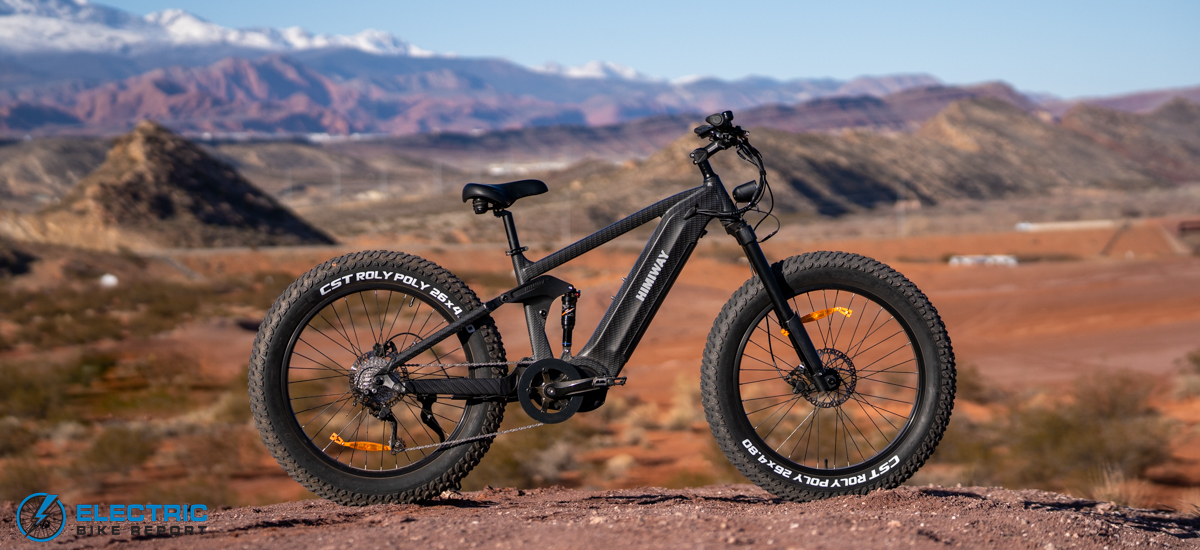
The Cobra pro features a full suspension system, a beastly 1000W mid-drive motor with a torque sensor, and some seriously huge and chunky 26” x 4.8” CST tires. These combine to give the bike true off-road capability, and a large degree of comfort in more rugged environments.
The bike also has an impressive maximum range of over 60 miles thanks to that mid-drive, but also its gigantic 960 Watt-hour (Wh) battery. In the case of many e-bikes with relatively small amounts of output in their low pedal assist system (PAS) settings, this wouldn’t mean a whole lot – but the Cobra Pro pumps out a fun and practical amount of assistance even in PAS 1.
The Cobra Pro’s awesome power makes it an uphill champion, too – but you’ll have to read on through our review of the Himiway Cobra Pro to see how it compares to some of the other fat tire e-bikes we have put to the test!
*Himiway is sharing some savings with the EBR audience! When you click the button above and use the discount code ELECTRICBIKEREPORT you will save $50 at checkout!.
*Editor’s Note: Updated Nov. 20th, 2023 to include award badge, and links to latest info and pricing.
 Pros
Pros- A true all-terrain e-bike! The Cobra Pro’s full suspension, beefy mid-drive motor, responsive torque sensor, and massive 26” x 4.8” knobby tires allow the bike to feel comfortable and capable on the same rough trails and loose terrain that dirt bikes frequent.
- Climbs hills like a boss! A fierce 1000W motor with up to 160 Nm of torque gives the Cobra Pro all the grit it needs to surmount even the steepest summits.
- Fantastic range! The combination of a gigantic 960 Wh battery and a practical level of power in Eco Mode / PAS 1 provides an impressive maximum range. We traveled over 60 miles on a single charge.
- Great bang for the buck! For its price point of around $4000, the Cobra Pro performs well and is outfitted with a respectable array of quality components. Without a significant jump in price, you’d be hard pressed to find a better-specced all-terrain workhorse.
- A solid and stable bike with the ability to move tall and/or heavy people. The Cobra Pro feels completely able to match its claimed capability of hauling riders between 5’-5” to 6’-6” and up to 400 lbs.
- Ride customization! With a 10-speed drivetrain, 5 PAS levels in both Eco and Sport modes, and the ability to adjust top speed through the bike’s user interface, the Cobra Pro’s ride feel can be tailored to fit its environment.
- User-friendly interface. The bike’s full-color LCD display shows all relevant ride data clearly, and includes a greatly appreciated percentage-based battery life indicator.
 Cons
Cons- While we always appreciate seeing hydraulic disc brakes on e-bikes, we felt that the 180 mm rotors used by the Cobra Pro didn’t quite meet our expectations. An upgrade to 204 mm rotors would provide a better balance to the bike’s weight and power.
- Such a powerful mid-drive motor will require good shifting etiquette. Shifting under load will quickly wear down your cassette meaning you’ll have to do maintenance more frequently if you’re not careful.
- Battery : 48V, 20Ah (960Wh) Samsung/LG lithium battery
- Display: LCD display with USB charging
- Motor: 1000W mid-drive motor
- Headlight: 48V LED light
- Taillights: Battery powered bike light
- Pedal Assist: 0-5 level pedal assist
- Range: 60-80 miles
- Throttle:Thumb throttle
- Claimed weight: 88 lbs.
- Total payload capacity: 400 lbs.
- Brakes: Tektro 180mm hydraulic brakes
- Fenders: Not included
- Fork: Alloy air front suspension fork with oil pressure lockout
- Frame: 6061 Aluminum frame
- Drivetrain: Shimano 10 speed gear shift system, 11-34T gearing
- Saddle: SR saddle
- Kickstand: Heavy-duty aluminum
- Pedals: Alloy pedals with reflectors
- Tires: 26” x 4.8” CST fat tires
Himiway Cobra Pro Review: E- Bike Overview
You might be wondering what separates the Himiway Cobra Pro from its little brother, the standard Cobra. At a glance, very little; their frames are exactly the same, their tires are identical, and even their spec sheets share many components. There are, however, two main differences:
First, and most notably, in their motors. Where the original Cobra employs a 750W rear hub motor, the Cobra Pro features a 1000W mid-drive motor. This is an appreciable bump in power that we saw clear evidence of in our testing, but it does come with a tradeoff; the inclusion of such an aggressive motor does push the Cobra Pro outside of the 3-class system that plays a significant role in determining the legality of e-bikes. We recommend checking your local laws, but in most cases, e-bikes with motors over 750W are likely to only be legal in off-road settings. In the case of the Cobra Pro, this isn’t a fault (to the contrary, it makes the bike more capable in its natural environment), but it is something to be aware of.
Second, in their gearing. The standard Cobra makes use of a 7-speed mixed Shimano system with a Tourney derailleur, an Altus shifter, and a 14-28T cassette. The Cobra Pro again shows an appropriate upgrade, with a full Shimano Deore 10-speed system, and an 11-34T cassette. Those extra gears felt very appropriate on the Cobra Pro, especially when in higher PAS settings.
Even with squishy front suspension forks, many of the hardtail fat tire e-bikes on the market are not well-suited for loose and rocky ground. The Cobra Pro’s full suspension and 1000W mid-drive with a heckin’ huge amount of torque do a lot to separate it from a large number of these other models that are regularly (mis)labeled as all-terrain e-bikes. Those features, combined with a torque sensor and chunky 26” tires, give the bike the power, responsiveness, and comfort needed to handle difficult terrain confidently.
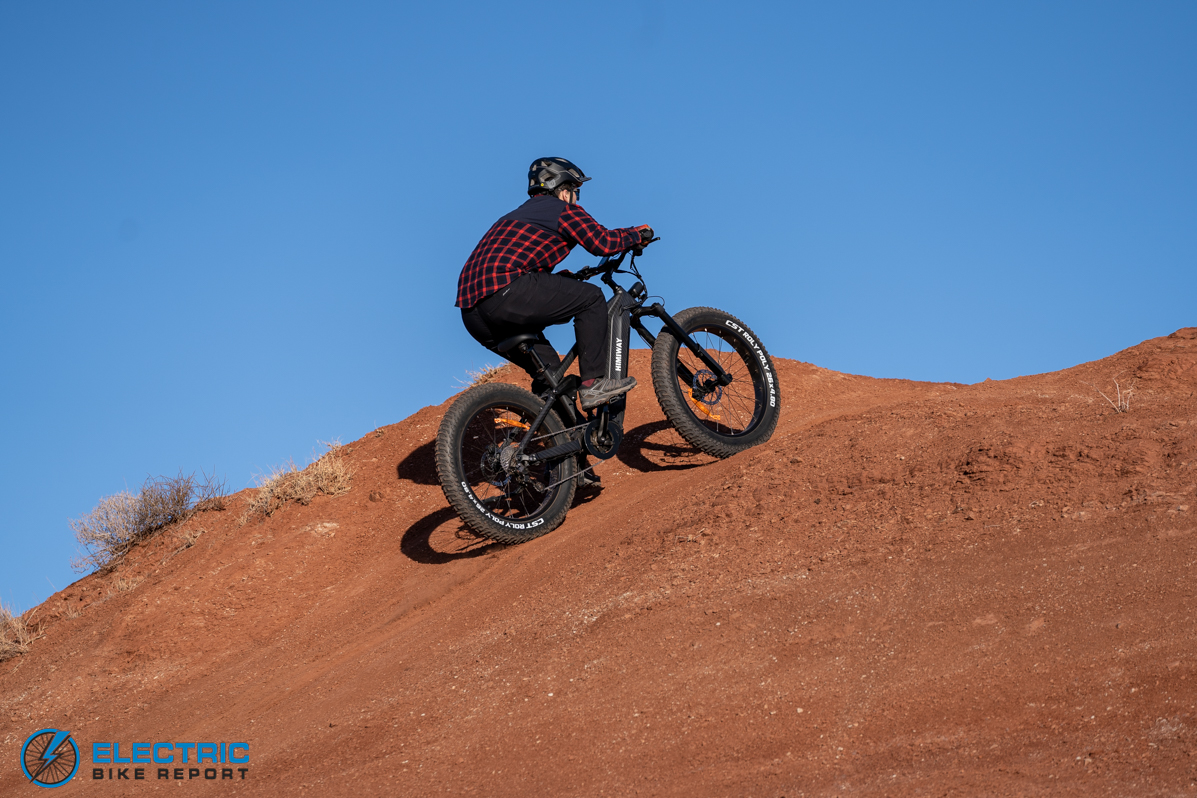
Even on steep slopes with loose terrain, the Himiway Cobra Pro finds a way to climb.

The massive 960Wh battery is how discreetly in the down tube.

The Bafang 1000W mid-drive motor makes the bike a power house of speed and climbing prowess.
With those things in mind, I do want to clarify one element of the Cobra Pro’s marketing. Himiway labels the bike as a “softail mountain bike,” which we feel might not paint its picture clearly. Serious mountain bikes (MTBs) and eMTBs are generally built for extreme performance; they’re often much lighter in weight, and use top-tier components that can be pushed beyond the capabilities of less specialized (and far less costly) parts. Once again, this is NOT a failure of the Cobra Pro – we are very pleased with its spec sheet and capabilities considering its price – but we do feel it’s important to understand the bike’s limitations. For this reason, we prefer the descriptor “full suspension, all-terrain e-bike.”
The team here at Electric Bike Report was admittedly a bit skeptical about the Cobra Pro’s advertised range of 60-80 miles on a single charge. We’re getting into spoiler territory here, but the Cobra Pro delivered, and with good reason. Mid-drive motors – especially those with torque sensors – are known for being more energy efficient thanks to their reliance on effort from the rider, and as such, are splitting the work (to some degree) at all times. Add in a ridiculously high-capacity 960 Wh battery, and you have a recipe for some serious mileage.
Additionally, Himiway gave us some details on the uncommon technology that their battery employs, which we’ll cover more about further down in the Cobra Pro review. Let’s get into it!
Himiway Cobra Pro Review: Circuit Speed Test
When putting the Cobra Pro’s Bafang 1000W mid-drive motor through its paces in our Circuit Test (see the graphic above for details), we had an unusual amount of work cut out for us. This is because the bike technically has 10 pedal assist settings, though this isn’t immediately apparent. By holding the “+” button on the bike’s control pad, the Cobra Pro can switch between Eco Mode and Sport Mode. Within each of those settings, there are 5 PAS levels.
Cases like this are a perfect example of why we perform our Circuit Test; we felt it was important to get a thorough understanding of how the Cobra Pro behaved in each of its 10 settings – and with no motor assistance at all. This test gave us a framework with which to gather measurable data for comparison purposes between the bike’s two modes.
My first lap without help from the motor was understandably slow, due to the Cobra Pro’s hefty 88 lbs. That said, its weight seemed to be balanced enough and its gearing seemed to span a wide enough range to make pedaling without assistance fairly pleasant for such a heavy bike.
When looking at the bike’s PAS system, let’s dive into Eco Mode first:
Plenty of the e-bikes we test have relatively low-powered assistance levels toward the bottom of their spectrum, but the Cobra Pro RIPS! As the graph above shows, I was hitting roughly 18 miles per hour easily even in the bike’s lowest setting. I did have to work a bit more on the uphill segment (as we see commonly in PAS 1), but on flat ground, the Cobra Pro was refreshingly powerful.
PAS 2 ramped things up slightly, and I felt noticeably more comfortable on that hill in PAS 3. Both PAS 4 and 5 delivered thrilling speeds on the top end of the Cobra Pro’s achievable limits and handled the small incline without breaking a sweat.
Now for Sport mode:
Here, we saw measured increases in speed as shown in the graph above, but the changes in the bike’s ride feel were pretty subtle. I did notice one distinct difference, but before I explain that, I want to elaborate on the differences between torque and cadence sensors for context.

The Himiway Pro lives up to it’s all-terrain designation: dirt, rock, and even sandy areas are within it’s wheelhouse.

The CST Roly Poly 4.8” tires enable the bike to ride well in offroad settings.
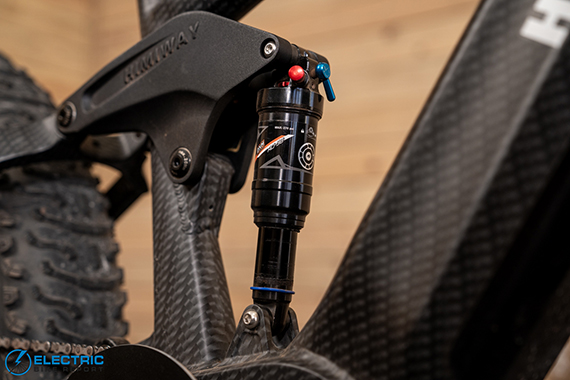
The rear suspension isn’t high-end, but it gets the job done allowing you to really play in rough terrain in relative comfort.
In Eco Mode, it seemed as though the Cobra Pro’s motor sent out shorter bursts of power with each pedal stroke. This resulted in a slightly jerky ride feel – though this was subtle enough that I don’t think many riders would even notice it. Sport Mode, however, seemed to provide longer bursts of power that made for a smoother ride overall.
When looking at our Circuit Test results, it is pretty clear that the Cobra Pro’s motor assistance increased pretty steadily throughout its PAS levels, which is something that we don’t always see, but love to acknowledge when we do.
To address the dip in the graph’s Sport Mode line in PAS 3, I am confident that I just got a bit lazy on that particular lap. This reinforces two things: first, that neither we, nor our tests, are perfect; and second, that (as I described above) motors with torque sensors rely on rider input to know how much power to give.
In summary, this test highlights the fact that the Cobra Pro’s two modes, 5 PAS settings, mid-drive motor, and torque sensor allow for a surprisingly customizable ride. This makes the Cobra Pro highly adaptable to its environment AND its rider.
Himiway Cobra Pro Review: Range Test & Battery Performance
Our Range Test is a method for evaluating battery performance, but it also allows us to get an idea of the efficiency of a bike’s motor/battery pairing. Additionally, it gives us a bracket of real-world distance measurements that we can compare to manufacturer’s claims. We give a brief description of how we perform this test in the graphic above.
Previously, I mentioned our skepticism regarding Himiway’s claims that the Cobra Pro could reach 60-80 miles on a single charge. This was primarily because of the bike’s 1000W motor (which we assumed was a power-hungry beast), its substantial weight (an 88-lb frame is not uncommon, but it’s still a lot of bike for the motor to move in addition to a rider), and the fact that it uses the same size battery as the standard Cobra – a fully-integrated 48V, 20 Ah (or 960 Wh) battery with Samsung/LG cells.
Regarding Himiway’s advertised range, I was happy to learn that they performed their own range test on the Cobra Pro under thoroughly documented conditions. According to our contact, their test was performed on a flat road, with light wind, a temperature of around 77°F, a roughly 132-lb rider, and a speed of about 15 miles per hour.
In our test, the Cobra Pro succeeded in meeting Himiway’s claims, though there are a few caveats to examine in relation to our data. Considering the bike’s two modes, we performed range tests at the two extreme ends of the spectrum – with maximum assistance in Sport Mode / PAS 5, and with minimum assistance in Eco Mode / PAS 1. These trials were also primarily held on paved multi-use paths with a 20 mph speed limit, so we reduced the Cobra Pro’s top speed to adhere to this regulation. With the bike in its standard settings, its range data may have been different. Again – with its 1000W motor, this bike is meant for off-road use, so our test environment is likely to be different from the areas consumers will use it.
With maximum assistance, we saw a range of roughly 42.5 miles, and with minimum assistance, we reached just over 64 miles. This was impressive, but there are a few more considerations to take into account here.
The Cobra Pro’s battery capacity is admittedly gigantic – when looking at previous e-bikes we have tested, it’s among the highest we have seen without getting into dual-battery territory. It also features unique technology that Himiway provided some detailed technical information on. Without getting lost in the weeds, just know that the cells that make up the Cobra Pro’s battery are larger than standard cells in both diameter and length, giving them a significantly higher capacity. Their chemical composition also allows them up to 20% higher energy density than standard cells, allowing for a smaller battery but a larger capacity.
Of course, the Cobra Pro’s high-capacity battery powers its Bafang 1000W motor that I mentioned earlier. This motor likely does wonders to increase the bike’s efficiency (and therefore its range) thanks to the fact that it is a mid-drive instead of a hub motor. Due to their positioning within the bottom bracket, mid-drive motors naturally split the work needed to move a bike with its rider. This requires less energy to be drawn from the battery, allowing it to last longer – and move the bike across a greater distance before running out of charge. So – while the Cobra Pro’s motor is extremely powerful, it makes for a more efficient pairing with its battery than the standard Cobra.
This is a good time to bring up a feature of the Cobra Pro’s motor that likely skewed our test results to some degree. We noticed during our range test in Sport Mode / PAS 5 that, after going only about 21 miles, the motor’s power dropped significantly when the battery hit 25%. At this point, the display read only about 375W in motor output, and climbing hills suddenly became much more difficult. Despite feeling this unusual drop-off, we continued and finished our range test, then reached out to Himiway later to determine what had happened.
We learned that the Bafang motor has an overheat protection feature that limits its torque output when activated. This kicks on when the motor overheats from working hard and drawing a large amount of current from the battery. The fact that the motor HAS this feature is excellent – it prevents the motor from heating up to the point that it sustains damage and/or fails – even if it resulted in our max PAS distance getting stretched out by a few miles.
This feature seems to encourage the full use of all of the Cobra Pro’s settings to match its environment. Considering how functional the bike is on rough terrain even in lower PAS settings, it seems best to keep it set at a low-to-mid level most of the time. Bumping its power level up to a high PAS setting only when it is truly needed, and reducing it again when it is not, should help to prevent the motor from overheating.
Himiway Cobra Pro Review: Hill Test
I’ve already mentioned how the Himiway Cobra Pro is a champion hill-climber, but it’s time to bring that point home. You can read about our Hill Test in the graphic above, but know that our test hill is an extreme challenge that has sent more than a few e-bikes packing.
The Cobra Pro would laugh at those failed e-bikes if it could. In Sport Mode / PAS 5, the Cobra Pro made the climb in one minute and two seconds, and with just its throttle, it was one second faster. The numbers are telling, for two reasons: first, we typically see slower throttle-only times; and second, the Cobra Pro’s data puts it squarely in the top 3 across all of the e-bikes we have tested. Of course, the 160 Nm of torque that its 1000W motor puts out does a lot to explain the bike’s stellar performance!
This seems like as good a time as any to bring up our only other major point of critique regarding the bike. And to be fair, it’s not just the Cobra Pro. When testing e-bikes with mid-drive motors, we’ve commonly seen unusually rapid wear on their cassettes, specifically in their highest (smallest) gears, due to their massive amounts of torque. During our testing of the Cobra Pro, we saw enough wear to warrant asking Himiway for a replacement (which they graciously provided), though the second cassette also began to show wear quickly. We reached out again with further questions about the issue.
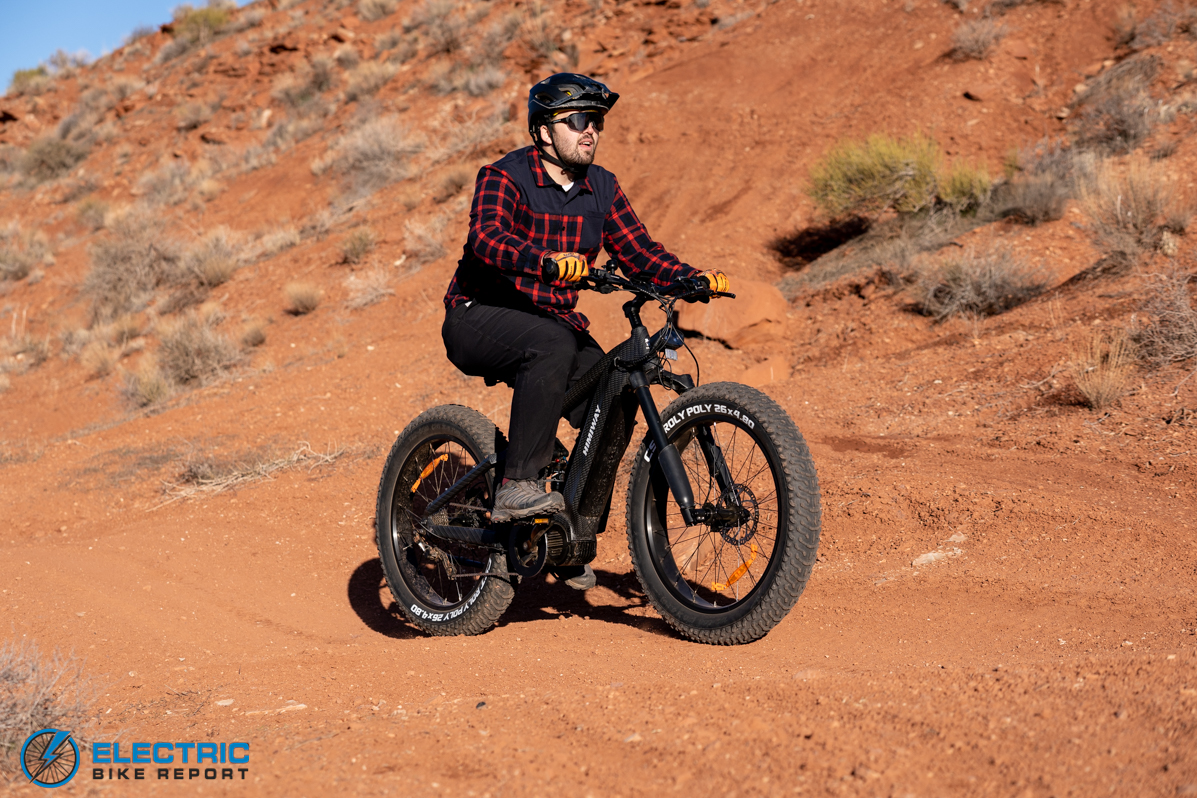
The Cobra Pro’s combo of features makes for a thrilling off-road experience

The handlebar is a smidge narrow for our preference, and the bell feels funny and out of place, but the cockpit is solid overall for control and comfort
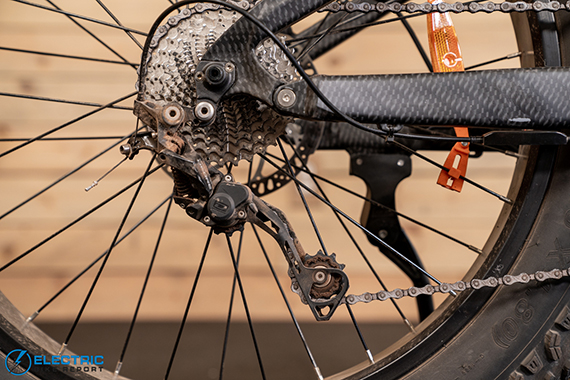
The Shimano Deore drivetrain is one of the handful of upgrades found on the Cobra Pro vs the Cobra, and it’s nice to have the expanded range in offroad environments.
Jumping back to hill performance, I mentioned previously that the Cobra Pro was very functional on an incline in Eco Mode / PAS 1 with some effort. Pedaling uphill becomes much easier in higher PAS settings, and switching to Sport Mode does provide a noticeable increase in motor output to help on a slope.
We put the Cobra Pro through its paces outside of our official test, too; it took 100-foot sand dunes and steep, rocky dirt hills in stride. Few other two-wheeled vehicles without gas-powered motors could handle some of the conditions we got to play in with this bike. In the words of my fellow reviewer Griffin (seen in the action photos within this Himiway Cobra Pro review), “The Cobra Pro makes the impossible seem possible.”
Himiway Cobra Pro Review: Safety and Brake Test
To test brake systems, we do our best to replicate a near-emergency situation that a rider might encounter. We pedal each bike that we test up to 20 miles per hour, then apply the brakes to stop as quickly as possible while maintaining control. Once the bike has come to a complete stop, we measure the distance it traveled as the brakes were applied. Then, we repeat this process two additional times and average the results.
In the case of the Himiway Cobra Pro, we measured an average stopping distance of 26’-1”. This is quite a bit longer than our current average when comparing the bike to similar all-terrain models we have tested, and I attribute these results largely to the extra weight of the Cobra Pro; many of those similar models weigh in roughly 15-20 lbs under the Cobra’s 88 lbs.
While this performance isn’t terrible, it does leave something to be desired. Considering how powerful the bike is when getting up to speed, we feel it could use a bit more help in slowing back down; we’d love to see Himiway upgrade the Cobra Pro’s 180 mm brake rotors to larger and more efficient 204 mm rotors. These larger rotors would disperse heat better and allow for better modulation – which would allow for better control in off-road environments.
When it comes to other safety features, the Cobra Pro does not have much to speak of aside from its front headlight. This is actually a relatively unique component due to its two LEDS and automatic light sensor. I was pleased to notice that the light was quick to activate when I rode through a tunnel, and I appreciated the extra width put out by the dual LEDs. According to the spec sheet, the bike IS supposed to have a rear light as well, but this was not included on our test bike.
Aside from the headlight, the Cobra Pro has a single front reflector and spoke-mounted reflectors on both wheels. Low tech, but always good to have.
Himiway Cobra Pro Review: Ride Comfort & Handling, Cockpit, and More
The most obvious and important thing to discuss about the Himiway Cobra Pro’s ride comfort is the bike’s full suspension. Spec-wise, the suspension provides a budget-friendly but functional package of components. The front suspension fork on our test bike was unbranded, but we liked seeing that it was an air/oil fork instead of a spring-based model. The rear shock was a DNM AO-38, which performed well in our testing but again, is a budget component.
In practice, these parts provided a feel that I was pleased with overall. I thought the Cobra Pro felt a bit stiff on paved surfaces, but it loosened up and became a lot more comfortable on dirt and sand. There, the bike’s rear suspension added a cushy layer of comfort to bumps that I greatly appreciated. That said, if you’re planning to use the Cobra Pro regularly in demanding environments, you might want to consider upgrading the stock parts for better performance and longevity. To repeat, a mountain bike this is not.

The color LCD is easy to see which is nice given the 10 different PAS modes you can choose from.
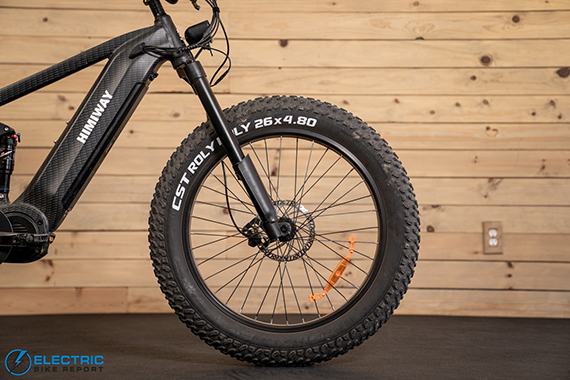
Another upgrade to the Cobra Pro is the inverted moto-style air/oil front fork vs the spring fork found on the base Cobra.
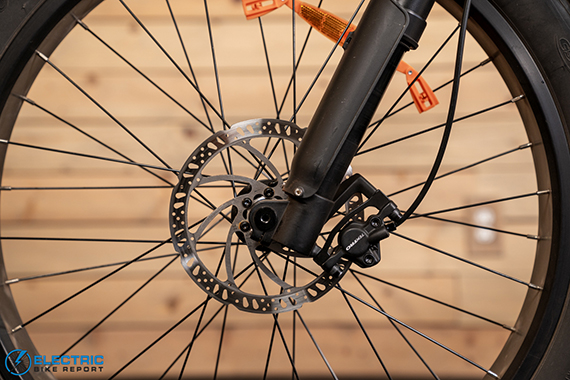
The Tektro hydraulic disc brakes work well, but given the bike’s weight we’d welcome a larger 203mm rotor in the future instead of the 180mm.
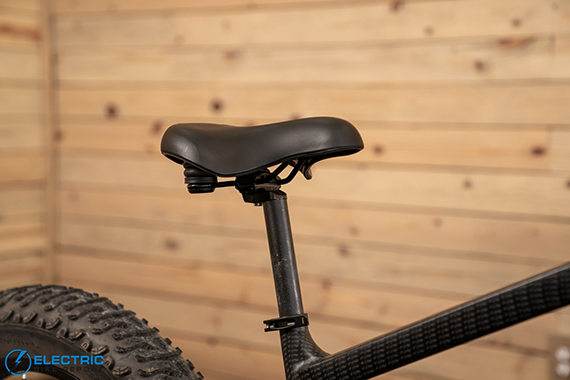
The saddle offers decent support and comfort, but if you plan on doing longer rides you make sure it’s supportive enough for you first or consider an upgrade.
In our review of the Himiway Cobra Pro, we’ve established that this bike is BIG. The relatively long wheelbase, large wheels, and huge tires do cause its handling to suffer a bit. In my experience, it was not a problem, but be aware: this is definitely not the most maneuverable e-bike out there.
Part of this is in relation to its relatively narrow handlebars. Many of the testers here at EBR were surprised to see the bike’s 700 mm handlebars, especially after reviewing some of the Quietkat all-terrain e-bikes like the Apex Pro that allow for wider hand placement. Once again, we did not feel that the handlebars on the Cobra Pro were a problem, but we did unanimously agree that wider felt better for all-terrain applications.
The Cobra Pro’s cockpit layout is solid, with all of the essentials included and well-distributed. The bike’s left handlebar hosts the front brake and throttle levers, as well as the control panel. Personally, I think this might be my favorite control pad yet; it is a nice middle ground that balances size, layout, and functionality. The harder buttons closest to the grips (appropriately) adjust PAS level, while the rubberized cluster further from the grips turn the bike and the headlight on/off, adjust the information shown on the display, and access the bike’s settings. In the center is the bike’s full color Bafang LCD display, with well-organized and easily readable information. The light sensor for the front headlight also ties into the display, so its brightness adjusts in low-light conditions. The Cobra Pro’s right handlebar features the rear brake lever, Shimano Deore under-the-bar shifter, and a bell. Of the all-terrain bikes we’ve tested, this shifter again stands out as a favorite.
Himiway Cobra Pro Review: Summary / Where to Buy
We’ve named the Himiway Cobra Pro Best Electric Bike for Hunting.
When testing the Himiway Cobra Pro, I kept returning to one thought: just with how much fin I was having it was remarkably difficult to find a flaw in this bike! Is that subjective? Sure – but as we’ve discussed, the bike’s performance also backs that up more substantially.
While it is a bit noisy, the Bafang 1000W mid-drive motor goes a long way in giving the Cobra Pro the confidence it needs to handle rough terrain and otherwise impossible hills. Any rider will appreciate both the amount of power the motor can deliver, and the speed at which it can be felt. The bike’s full suspension, while on the budget end of the spectrum, makes traveling in untamed environments more comfortable and ultimately more enjoyable. And the bike’s pairing of a mid-drive motor with a high-capacity battery, in combination with an effective minimum PAS setting, give it a sizable range.
That said, it’s not perfect, no matter how close it might initially seem. When considering the Cobra Pro’s brake test results, we’d appreciate seeing an upgrade to 204mm rotors in the future. These would more appropriately match the bike’s power and weight in off-road settings.
Additionally, while it’s far from the only e-bike we’ve seen the issue appear on, there is the issue of unusual wear on the bike’s cassette. The torque generated by the mid-drive motor and applied through the chain to the cassette can – without an additional level of care and the formation of specific good habits – cause damage requiring the costly replacement of components.
The bottom line with the Cobra Pro is that this is a different kind of e-bike that requires a unique level of understanding (and probably some personal adaptation) to use effectively. Getting to know the bike and its limitations – and correctly applying the full scope of its electronic and manual settings – is imperative to reach the extent of its capabilities.
With some time and care, this fierce and competent e-bike can take you wherever you want to go, whether that be a short romp in the dirt or a lengthy trek through the wilderness. If you’re an adventurer, a hunter, or just a fun-seeking daredevil, we think you’d be hard pressed to find an e-bike better able to handle extreme environments for a better price.
Happy Riding! Make sure to let us know if you have any questions down in our comments section or if you think we left anything out in this review of the Himiway Cobra Pro.




Excellent, fair-mined review. Which bikes were the two fastest in the hill climb test?
Thank you! At this point in time, The Eunorau Defender S and the Quietkat Jeep are the Hill Test champions!
When testing the Cobra pro and noticing excessive cassette wear…had you been following the recommended “shifting etiquitte” and still got wear? Have you tested the cassette longevity using proper shiftingtechniques? Considering a bike purchase but the rapid wear gives me pause
Hi Ken, great question! With proper shifting techniques, we did still experience wear, but it was significantly improved.